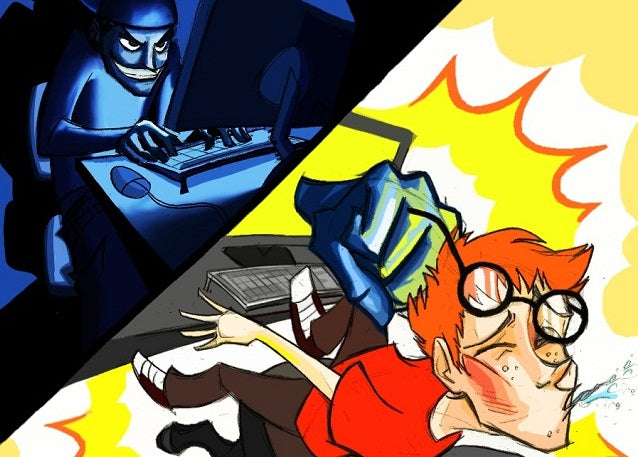Explore our collection of informative and educational blog posts to stay updated on the latest industry trends and expert advice.
15 Strategies Educators Can Use to Stop Cyberbullying

The advent of technology has brought with it familiar problems in new forms. Yet cyberbullying is unique in many ways.
What makes cyberbullying so different than in-person bullying?
- It is often anonymous and unlimited by time and place so the victim has little respite from the abuse.
- There is an element of disinhibition due to anonymity where students who would not normally participate do so. It can reach hundreds or even thousands of people quickly. The victim can feel even more isolated.
- It often involves repeated episodes of aggression and an imbalance of power. The victim may feel escape is impossible.
- More females are the victims and perpetuators of this type of bullying.
As educators, we need to be specifically aware of cyberbullying. Why is it so important to address cyberbullying in schools first? The Center for Safe and Responsible Internet Use, argues that two thirds of school violence begins through social media. Cyberbullying can lead to school failure, psychological implications, depression, violence and illegal activity.
An Educator’s guide to Cyberbullying and Cyberthreats defines the behavior as verbal aggression such as:
- Harassment or repeated insults through various forms.
- Defamation of a person’s character through derogatory postings, rumors, or images.
- Flaming or fighting messages using anger and vulgar language.
- Outing or deceiving someone into sharing secrets or private information.
- Polling such as posting an image on a voting website to make fun of a person’s looks.
- Impersonation or identity theft to embarrass or destroy a person’s identity.
- Cyber Stalking including sending intimidating or threatening messages.
- Sexting including sexual solicitation and/or exploitation.
- Unsafe digital communities with shared interests, such as social communities that validate eating disorders, violence, or drug use.
Although the research about cyberbullying is still emerging, there is some consensus on best practices. There are a few things we can do as educators to curtail cyberbullying
- Create digital citizens. Cyberbullying is impersonal in nature. It is important to teach kids that the same rules apply in and out of the digital world. Clearly teach students how to be cyber safe and savvy. CSRIU (the Center for Safe and Responsible Internet use) provides some free handouts tailored by grade level to teach students how to be safe online. Microsoft even provides a free instructional program to teach digital citizenship and ethical use of technology. Much like rules are taught, digital citizenship can be imparted through explicit teaching.
- Raise awareness. Awareness is powerful. It changes social perceptions. Rather than create panic over technology use or spread misunderstandings, awareness allows a positive atmosphere to emerge. Put cyberbullying in the spotlight in your classroom.Teach students about the psychological and legal ramifications. Explore issues like technology risks, cyber safety and positive online communities. Talk about age-appropriate cases of cyberbullying and their resolution. Showcase how technology is being used to help people in your community. Show students how they can use technology for the greater good. For instance, a new trend is creating a managed space for classmates to compliment each other on school achievements or work together on a class project.
In 81% of violent incidents someone other than the attacker knew what was going to happen but did not report it.
-
Teach students it’s okay to report abuse. Students need to know that they should report abuse. The Columbine Commission report reported that in 81% of violent incidents someone other than the attacker knew what was going to happen but did not report it. It is important to break the silence surrounding cyber abuse. Victims often do not report abuse for several reasons:
- They fear retribution from peers.
- They have anxiety that adults will remove computer or cell phone access.
- They don’t think adults will know how to resolve the situation. Often, adults may respond by removing technology from the victim, which is often seen as a punishment. Let kids know it’s not technology that is the problem, but irresponsible use. Give examples of how situations where resolved that involved cyberbullying, so they trust turning to you.
- Establish firm policies. Rules regarding technology need to be explicitly taught, rather than assumed. A student should be aware of policies before a problem occurs. Create clear boundaries. Policies serve as a good way to curtail verbal aggression and establish it as an unacceptable behavior. Policies should also be specific, including any legal implications. Here is an example of a written policy address sexting, that provides clear information.
-
Realize that younger generations identify more closely to their online presence. As an adult, it is easier to separate yourself from online interactions. But younger generations may have a more difficult time with this. What happens online is very serious to them, and they do not take it lightly. Their online persona is essentially the same to them as their real person. If a student approaches you about a problem, don’t try to minimize it. Find resources immediately and make it apparent that you understand it is a serious issue.
- A webinar mentioned in the Examiner, “When Cyber bullying spills into schools” recommends using a 5 prong method (The 5 R’s) when addressing cyberbullying situations. Respond always, Research facts, Record documentation, Report findings, and Revisit the issue to make sure it is resolved.
-
Team Building.Team building is a powerful way to make groups behave cohesively. I once saw a group from the US Army go to a local middle school to do team building exercises. Using a rope and a few random objects, the students had to work together to lift an object. The purpose of the activity was to make all members of the class work together towards a common goal.They had to use all of their individual strengths and realize each person’s abilities were necessary to complete the task. Teachers might consider having a weekly class meeting or similar activity. Create activities that might involve students to socialize with others that they might not normally engage with.
[ois skin=”In post”]
- Encourage education for teachers, administrators, and counselors. Cyberbullying problems frequently change due to the changing nature of technology. It’s important to stay up to date. A recent study in Childrens & Schoolsfound that half of school social workers felt ill-equipped to handle cases of cyberbullying. Education is essential.Many free webinars and workshops are available to educate teachers. For instance, “Guarding Kids Against High Tech Trouble” provides great multimedia training resources. There are many paid consultants and non-profit organizations that provide free resources specializing in this area. Billy Belsey, the Canadian Educator who coined the term “cyberbullying” is one such activist who provides teacher training.
- Get Parents Involved. Parents may often be unaware of cyberbullying, so it is important to report what is happening so that they can intervene at home. Some data suggests that blocking the person may be the best way to stop the abuse. A study by the Center for the Prevention of Violence, said that 70% of teens said that blocking cyber friends stopped the abuse. Educators might suggest parents buy filtering software or special phones for younger children and teenagers.
- Establish open communication with students. Students need to know who and where they can go to before a problem occurs. By the time a situation escalates, it may be too late. Students may be so stressed with their situation that they may not be thinking logically. It’s best to make resources clear and available before situations become muddled with stress. You can have an anonymous box to report cases so that students know they can feel safe to report information. Organizations such as Safe2Tell, allow students to report incidents anonymously. You might have your school establish a hotline, or contact a local organization.Knowing there is a way to report cases may also stop students from engaging in the behavior. Research suggests that a parenting style that is emotionally warm with clear limits best creates resiliency in regards to digital aggression. Teachers can follow the same example: Be clear, empathetic, and communicate openly with students.
- Allow technology in school. By incorporating technology in the classroom, teachers can focus on the ethical use of technology. Prohibiting technology often makes the problem worse. The behavior goes further underground. Teaching students how to use technology appropriately is better than having them figure it out with no guidance.
- Know when to use community resources. There may be situations that require the intervention of greater community resources such as counselors, administrators, and law enforcement. Cyberbullying needs to be taken seriously and getting the community involved may prevent larger problems.Offer counseling services to both victims and perpetuators. Let students know that it is okay to need to talk to someone. Some situations have legal ramifications, such as the distribution of child pornography and need to be reported to legal agencies immediately.
Cyberbullying policies should focus on changing school climate.
- Create a positive school environment. The National Bullying Prevention Campaign in the US, recommends establishing a school-wide approach that changes the overall climate of schools. It focuses on norms of behavior. One exceptional program at preventing violence is the Olweus Bullying Prevention Programthat focuses on improving peer relationships through a school-wide approach.It includes the support of classrooms through rules and class meetings. Some research suggests that cyberbullying may be more common in poor school environments. It is uncertain if these environments cause bullying or simply make it more acceptable. A positive classroom where individuals are appreciated and respected can spill over to the unity of the group and create a positive, understanding environment. Cyberbullying policies should focus on changing school climate.
-
Interventions should focus on restoration, rather than punishment. At times, punitive interventions increased retaliation to reporting students. Policies should hold aggressors accountable for conduct and focus on making amends. Addressing the situation in a healthy way avoids further incidences. These might include teaching students about healthy relationships, responsibility and empathy. It is vital to create opportunities for forgiveness and reintegration to occur. Punishment is different than restoration in that it focuses on the rule broken, rather than the overall behavior. Restoration aims to
- Acknowledge the behavior.
- Understand the harm that was caused to the person.
- Repair or amend the harm in some way.
- Commit to change so it does not happen again.
- Establish a baseline. Some studies and programs suggest having students participate in anonymous School Climate Surveys to see the extent of bullying and other types of behaviors occurring in the school. Red flags can be identified. This can give administrators clues as to what types of things to look for and address. You may want to do this in your own classroom.
- Zero tolerance policy. Make students understand early on that bullying of any kind, including cyberbullying is unacceptable. The Massachusetts Aggression Reduction Center, found that students reported “looks, not fitting in, and sexual orientation” as reasons for being targets. Students with disabilitieswere more likely to be targets of cyberbullying, than in person bullying.Teach students about being responsible world citizens who are accepting of individual differences. Make sure that groupings in the classroom allow students to work with different people. Try to create activities that build on strengths, to show students how each person has something unique to contribute. Incorporate responsible technology use. Teach tolerance and respect for diversity. An open environment is best where individual differences are appreciated.
Finally, as teachers, it is important to remember our duty to protect students’ human rights.
Eleanor Roosevelt described it so eloquently when she described how human rights begin very close to home. . . .
“Where, after all, do universal human rights begin? In small places, close to home – so close and so small that they cannot be seen on any maps of the world. Yet they are the world of the individual person; the neighborhood he lives in; the school or college she attends; the factory, farm, or office where he works. Such are the places where every man, woman, and child seeks equal justice, equal opportunity, equal dignity without discrimination. Unless these rights have meaning there, they have little meaning anywhere. Without concerted citizen action to uphold them close to home, we shall look in vain for progress in the larger world.”








